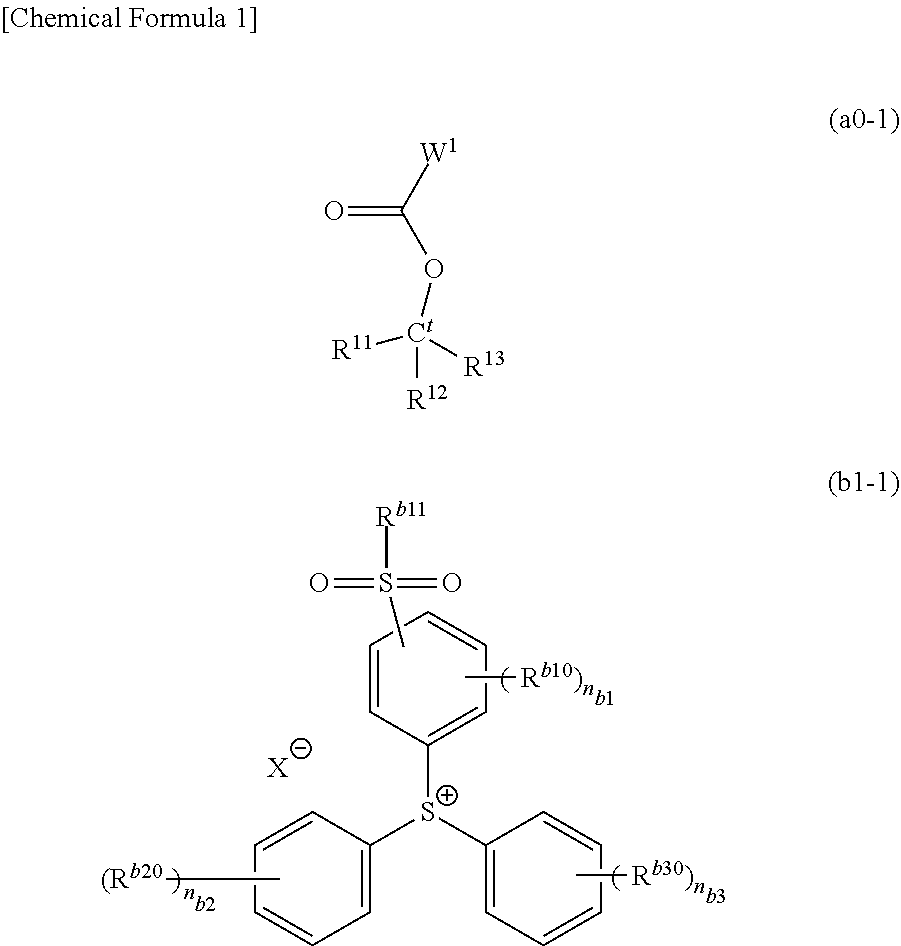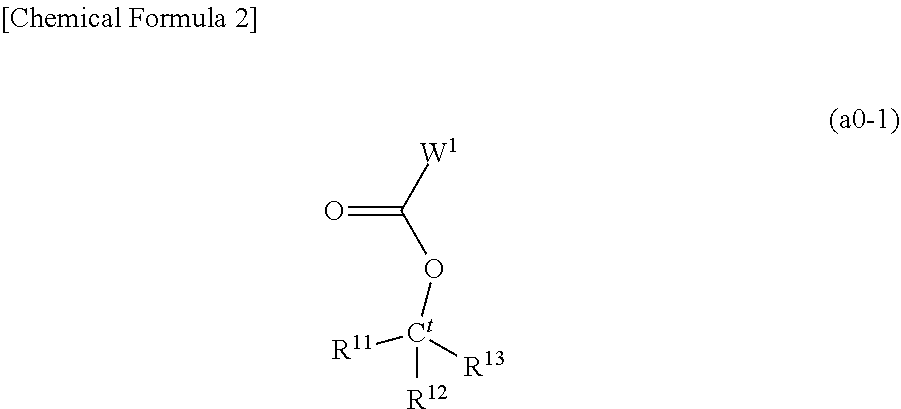Resist composition and method of forming resist pattern
a composition and resist technology, applied in the field of resist composition and resist pattern formation, can solve the problems of difficult to obtain the desired resist pattern shape or the like, difficult to satisfy both the sensitivity of resist composition and resist pattern shape, etc., to achieve enhanced sensitivity, good shape, and improved lithography properties.
- Summary
- Abstract
- Description
- Claims
- Application Information
AI Technical Summary
Benefits of technology
Problems solved by technology
Method used
Image
Examples
examples
[0655]As follows is a description of examples of the present invention, although the scope of the present invention is by no way limited by these examples.
[0656]In the following examples, a compound represented by a chemical formula (1) is denoted as “compound (1)”, and the same applies for compounds represented by other chemical formulae.
Production Examples of Copolymers (A1-1-1) to (A1-1-17), Copolymers (A1-2-1) and (A1-2-2)
[0657]Each of copolymers (A1-1-1) to (A1-1-17), copolymers (A1-2-1) and (A1-2-2) was obtained by a conventional radical polymerization, using monomers for deriving the structural units that constitute each copolymer in a predetermined molar ratio.
[0658]The obtained copolymers (A1-1-1) to (A1-1-17), copolymers (A1-2-1) and (A1-2-2) are shown below.
[0659]With respect to each copolymer, the compositional ratio of the polymers (the molar ratio of the respective structural units in the polymeric compound) as determined by 13C-NMR, the weight average molecular weight...
examples 1 to 17
, Comparative Examples 1 to 5
[0661]The components shown in Table 2 and 3 were mixed together and dissolved to obtain each resist composition (solid content: 2.0% by weight).
TABLE 2Component (B)ComponentComponentComponentComponentComponent(A)(B1)(B2)(D)(S)Example 1 (A1)-1(B1)-1—(D)-1(S)-1[100][15.0][5.0][6000]Example 2(A1)-2(B1)-1—(D)-1(S)-1[100][15.0][5.0][6000]Example 3(A1)-3(B1)-1—(D)-1(S)-1[100][15.0][5.0][6000]Example 4(A1)-4(B1)-1—(D)-1(S)-1[100][15.0][5.0][6000]Example 5(A1)-5(B1)-1—(D)-1(S)-1[100][15.0][5.0][6000]Example 6(A1)-6(B1)-1—(D)-1(S)-1[100][15.0][5.0][6000]Example 7(A1)-7(B1)-1—(D)-1(S)-1[100][15.0][5.0][6000]Example 8(A1)-8(B1)-1—(D)-1(S)-1[100][15.0][5.0][6000]Example 9(A1)-9(B1)-1—(D)-1(S)-1[100][15.0][5.0][6000]Comparative(A1)-18(B1)-1—(D)-1(S)-1Example 1[100][14.0][5.0][6000]Comparative(A1)-19(B1)-1—(D)-1(S)-1Example 2[100][14.0][5.0][6000]Comparative(A1)-1—(B2)-1(D)-1(S)-1Example 3[100][14.0][5.0][6000]Comparative(A1)-2—(B2)-1(D)-1(S)-1Example 4[100][14.0][5.0...
PUM
| Property | Measurement | Unit |
|---|---|---|
| Temperature | aaaaa | aaaaa |
| Length | aaaaa | aaaaa |
| Length | aaaaa | aaaaa |
Abstract
Description
Claims
Application Information
 Login to View More
Login to View More - R&D
- Intellectual Property
- Life Sciences
- Materials
- Tech Scout
- Unparalleled Data Quality
- Higher Quality Content
- 60% Fewer Hallucinations
Browse by: Latest US Patents, China's latest patents, Technical Efficacy Thesaurus, Application Domain, Technology Topic, Popular Technical Reports.
© 2025 PatSnap. All rights reserved.Legal|Privacy policy|Modern Slavery Act Transparency Statement|Sitemap|About US| Contact US: help@patsnap.com



